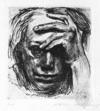- Kollwitz, Käthe
-
Koll·witz (kōlʹwĭts', kôlʹvĭts'), Käthe or Kaethe 1867-1945.
German artist whose sculptures and prints, including The Living to the Dead (1919), express her abhorrence of war and poverty.
* * *
born July 8, 1867, Königsberg, East Prussiadied April 22, 1945, near Dresden, Ger.German graphic artist and sculptor.She studied painting in Berlin and Munich but devoted herself primarily to etchings, drawings, lithographs, and woodcuts. She gained firsthand knowledge of the miserable conditions of the urban poor when her physician husband opened a clinic in Berlin. She became the last great practitioner of German Expressionism and an outstanding artist of social protest. Two early series of prints, Weavers' Revolt (1895–98) and Peasants' War (1902–08), portray the plight of the oppressed with the powerfully simplified, boldly accentuated forms that became her trademark. After her son died in World War I, she created a cycle of prints dedicated to the theme of a mother's love. She was the first woman elected to the Prussian Academy of Arts, where she was head of the Master Studio for Graphic Arts (1928–33). The Nazis banned her works from exhibition. The bombing of her home and studio in World War II destroyed much of her work. Self-Portrait with Hand on Forehead, etching by Käthe Kollwitz, ...B-7792 "Self-Portrait with Hand on Forehead," Kathe Kollwitz, National Gallery of Art, Washington, D.C., Rosenwald Collection
Self-Portrait with Hand on Forehead, etching by Käthe Kollwitz, ...B-7792 "Self-Portrait with Hand on Forehead," Kathe Kollwitz, National Gallery of Art, Washington, D.C., Rosenwald Collection* * *
▪ German artistoriginal name Käthe Schmidtborn July 8, 1867, Königsberg, East Prussia [now Kaliningrad, Russia]died April 22, 1945, near Dresden, GermanyGerman graphic artist and sculptor who was an eloquent advocate for victims of social injustice, war, and inhumanity.The artist grew up in a liberal middle-class family and studied painting in Berlin (1884–85) and Munich (1888–89). Impressed by the prints of Max Klinger (Klinger, Max), she devoted herself primarily to graphic art after 1890, producing etchings, lithographs, woodcuts, and drawings. In 1891 she married Karl Kollwitz, a doctor who opened a clinic in a working-class section of Berlin. There she gained firsthand insight into the miserable conditions of the urban poor.Kollwitz's first important works were two separate series of prints, respectively entitled Weavers' Revolt (c. 1894–98) and Peasants' War (1902–08). In these works she portrayed the plight of the poor and oppressed with the powerfully simplified, boldly accentuated forms that became her trademark. The death of her youngest son in battle in 1914 profoundly affected her, and she expressed her grief in another cycle of prints that treat the themes of a mother protecting her children, and of a mother with a dead child. From 1924 to 1932 Kollwitz also worked on a granite monument for her son, which depicted her husband and herself as grieving parents. In 1932 it was erected as a memorial in a cemetery near Ypres, Belgium.Kollwitz greeted the Russian Revolution (Russian Revolution of 1917) of 1917 and the German revolution (Germany) of 1918 with hope, but she eventually became disillusioned with Soviet communism. During the years of the Weimar Republic, she became the first woman to be elected a member of the Prussian Academy of Arts, where from 1928 to 1933 she was head of the Master Studio for Graphic Arts. Kollwitz continued to devote herself to socially effective, easily understood art. The Nazis' rise to power in Germany in 1933 led to her forced resignation from the academy.Kollwitz's last great series of lithographs, Death (1934–36), treats that tragic theme with stark and monumental forms that convey a sense of drama. In 1940 her husband died, and in 1942 her grandson was killed in action during World War II. The bombing of Kollwitz's home and studio in 1943 destroyed much of her life's work. She died a few weeks before the end of the war in Europe. Kollwitz was the last great practitioner of German Expressionism and is often considered to be the foremost artist of social protest in the 20th century. The Diary and Letters of Kaethe Kollwitz was published in 1988.* * *
Universalium. 2010.
